| St John's Cathedral

© St John's Cathedral
The Cathedral of St John the Baptist is the present day
Cathedral in Limerick City. The link between St John the Baptist and the
area around the Cathedral is long standing. According to Begley, the Knights
Templars had a house in the area in the 12th century that was dedicated
to John the Baptist.
After the Synod of Rathbrassil in 1111, St Mary's church became the first
cathedral church of the Diocese of Limerick. According to local tradition,
Donal O'Brien, the King of Thomond, donated his palace as the new site
for a Cathedral in the latter half of the twelfth century. As the Synod
of Rathbrassil occurred in the first half of the twelfth century, this
tradition is certainly false. Brian Hodkinson suggests that during Donal's
reign, the church moved to a new site on land provided by Donal. However,
following the Reformation, this Cathedral became the property of the Church
of Ireland.
See St Mary's Parish for more
details on St Mary's Cathedral.
William Hill, a Quaker, bought the site of the present Cathedral in 1796
and the land was kept in a secret trust, as Roman Catholics could not
buy land at that time. The foundation stone was laid on May 1st 1856.
The coins of the realm were placed in a phial together with an inscription
in eight languages. The then Bishop, Dr Ryan visited all the churches
of the diocese to collect money for the new church. Originally the plan
was to build a plain church for the 15,000 Catholics in St John's parish
to replace the old chapel of St John, which was built in 1753.
Due to the widespread response to the appeal for funds, Bishop Ryan decided
to convert the church to the Cathedral of the diocese. Philip Charles
Hardwicke of London designed it in the style of a Gothic Revival building
and the builders were Mr. Wallace & Sons. Hardwicke was chosen after
he won a competition to design the Cathedral. The decision caused some
annoyance as Hardwicke's design was picked ahead of many Irishmens' designs.
The church design was influenced by Salisbury Cathedral. The Cathedral
was built using blue Limerick limestone. Fr William Bourke PP, who was
parish priest during the building of the Cathedral, said the first mass
in the Cathedral on March 7th 1859. Fr Bourke died a few weeks later and
is buried in the Cathedral at the pillar of Belzoni's statue of Our Lady.
The Cathedral was opened for public worship in July 1861 but it had not
been completed at the time. The tower was incomplete and the interior
of the Cathedral remained to be decorated as well as the three side chapels.
The Cathedral measures 51 metres by 36 at the transepts. The nave measures
24 metres internally and consists of five bays and a clerestory.
St John's Cathedral has the highest spire in Ireland at 308 feet and
3 inches from the base of the tower to the top of the Cross. The Cathedral
is an example of Victorian Gothic design. The tower tapers into a spire
at 163 feet high. An iron cross was placed on the top of the spire on
27 September 1882. However three days later the cross was knocked during
a storm. Little damage was caused to the building and a new cross was
placed on the spire in August of the following year. A lighting conductor
was also placed on top of the spire in 1883. A firm of architects led
by Maurice Hennessy designed the spire and the builder was Mr. T. Byrne.
The Cathedral bell was cast in Dublin in 1883 and was transported by barge
to Limerick. The bell weighs one and a half tons.
The Cathedral was renovated in 1884 as the interior was in need of a
major restoration due to dampness. After this restoration, the consecration
of the Cathedral took place on June 21st 1894. It officially became a
Cathedral on January 7th 1912 in a decree by Pope Pius X, which also restored
the Cathedral Chapter.
More work has been carried out on the Cathedral since but this has mainly
been to keep the building in a good state of repair. A new copper roof
was put on the Cathedral during renovations in the early 1950s. Further
renovations were carried out on the sanctuary in the Cathedral during
the late 1970s and again in 2003. For more information on the most recent
conservation project, click
here.
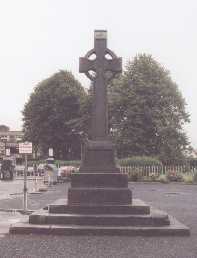
© Mission Cross
A sign outside of the Cathedral on the right marks the site
of the last Roman Catholic parish church of St John's. To the right of
the Cathedral, there is a Mission Cross, which was erected to commemorate
four missions: the Redemptorists Fathers in October 1851; the Oblates
of Mary Immaculate in May 1870; the Vincentian Fathers in May 1863; and
the Oblates Fathers during Lent 1952.
In the grounds of the St John's Prebystery, there is a statue to Patrick
Sarsfield, which was erected in 1881.
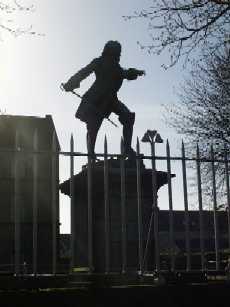
© Statue of Patrick Sarsfield
Inside the Cathedral
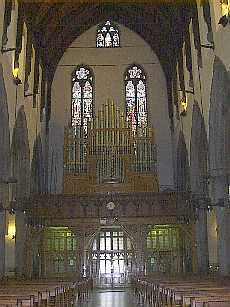
© Choir and main door of St John's Cathedral
Outside the Cathedral a statue of St John the Baptist has
been erected above the main door. A stained glass window in the west wall
of the nave depicts St Augustine and St Ambrose on the left and St Jerome
and St Gregory on the right. The inscription under the left-hand window
states that Robert Unthank erected the window to the memory of John and
Mary Unthank. The Reverend Daniel Synan erected this window on the right
in 1851 to the memory of Bishop Bulter who was once the administrator
of St John's. Above both windows is a stained glass window that depicts
the Descent of the Holy Spirit onto the Apostles.
Inside the main door of the Cathedral two flags hang down
from the choir. The first flag commemorates the Wild Geese who were men
who left Limerick after the Treaty of 1691. About 18,000 men remained
loyal to Catholicism and King James. The flag has a harp surmounted by
the Stuart Imperial Crown on a red cross. Two quarters on the flag are
red. Their motto was In hoc signo vinces, which means, "Through the
sign you conquer". This flag was erected in 1991 to commemorate the
300th anniversary of the Flight of the Wild Geese. The second flag over
the choir was made by the children of St John’s School to commemorate
the Conservation work on St John’s Cathedral in 2003.



© Pièta and Stained Glass Windows
On the left of the main door to the Cathedral, there is
a stained glass window in four sections. The top two sections depict Mary
and St Joseph, while the bottom two depict St Richard and St Theresa.
Directly beneath the window there is a large statue of the Pieta. To the
left of this, there is a statue to St Anne. The accompanying inscription
asks people to pray for the souls of James & Bridget Cross. On the
far right there is a statue of St Anthony. Near right, there is a statue
of Our Lady of Guadeloupe, the patron saint of the unborn. The Kennedy
family donated this statue in January 1995.
  
© Statues in St John's Cathedral
Along the left hand aisle of the Cathedral there are two
stained glass windows, which depict the sacraments of Confirmation and
Ordination.
There is a large Crucifix on the wall between the stained
glass windows of the Confirmation and Ordination. Further along the wall
of the aisle there is a stained glass window to the apostle St Thomas,
who represents the sacrament of Baptism.
Underneath the Crucifix there is a side door to the Cathedral.
The Mortuary Chapel was formerly used as the shop of the Cathedral and
during the renovations; a new external door in the style of the front
door of the Cathedral was erected. The internal door is made from clear
glass onto which an etching of the old church of St John’s, dated
1753 is imposed on the glass.




© Crucifix and Stained Glass Windows at the left of the Cathedral
In the left transept there is a painting of the Deposition
from the Cross by Limerick artist Timothy Collopy. This painting was originally
situated in the old penal Chapel of St John prior to the completion of
the Cathedral in 1861. A large stained glass window depicts various scenes
from the life of Jesus Christ. The centrepiece of the window shows the
Transfiguration of Christ, surrounded by Moses, Elijah, Peter, James and
John. Above this are Jesus and Mary Magdalene while at the bottom of the
panel is Christ teaching the Disciples.
To the left of this, the window shows Christ and St Peter above, and
the wedding at Cana beneath. Further left, it depicts Christ with the
Centurion, the miracle of the loaves and fishes and the temptation of
Jesus in the desert.
The right hand side of the window depicts Christ and the little Children
above and the raising of Jairus' daughter beneath. To the right of this
is the calming of the seas, the Sermon on the Mount and the raising of
Lazarus from the dead. Beneath this stained glass window, there is a memorial
to Bishop Edward Thomas O'Dwyer.
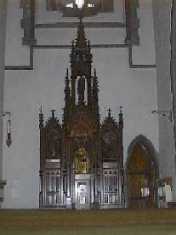
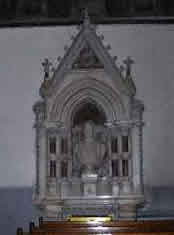
© Chapel to the Blessed Sacrament and Memorial to Bishop O'Dwyer
To the left of the main altar, there is a chapel to the
Blessed Sacrament. Over the chapel altar there is a stained glass window
of the Last Supper. This chapel used to contain the back and the canopy
of the former bishop's throne. This throne was carved out of Riga oak
in Munich in 1894. Carved in the wood are scenes of Baptism, the Crucifixion
and the Lamb of God. In the course of the restoration of the Cathedral
during 2003 and 2003, the baptismal font was moved into the left transept,
which was its original location. Behind the baptismal font is the new
aumbry, where the holy oils are kept. The aumbry was formerly the chapel
of the Blessed Sacrament. The aumbry is contained in the back and the
canopy of the former bishop’s throne.
Buried in front of the Blessed Sacrament Chapel are:
 Bishop Jeremiah Newman, Consecrated July 14 1974, Died April 3 1995
Bishop Jeremiah Newman, Consecrated July 14 1974, Died April 3 1995
 Most
Rev. David Keane D.D., Consecrated 1924, Died March 13 1945 Most
Rev. David Keane D.D., Consecrated 1924, Died March 13 1945
To the left of the chapel of the Blessed Sacrament there
is a chapel to St Joseph. Over the altar of the chapel there is a stained
glass window of St Joseph. The flight into Egypt and the wedding of Joseph
and Mary are depicted on panels on the altar. At the base of the altar
the death of St Joseph is depicted. There are two statues made by Mayer
of Munich in front of the chapel, one of which depicts St Joseph.
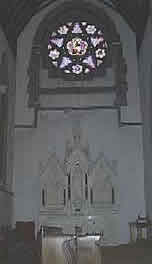
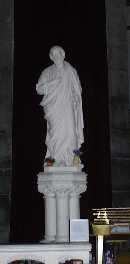
© Chapel to St Joseph and Statue of St Joseph
To the left of the chapel to St Joseph there are two stained
glass windows depicting St Michael and St Edmund. Mrs. Harriet O'Brien
donated the stained glass window of St Michael in memory of her father
Michael O'Neill.
On the wall are plaques to the following Bishops of the Diocese of Limerick:
 Bishop Denis Hallinan D.D., Consecrated Mar. 10 1918, Died July 2 1923
Bishop Denis Hallinan D.D., Consecrated Mar. 10 1918, Died July 2 1923
 George
Bulter D.D., Consecrated 1861, Died Feb. 3 1886 George
Bulter D.D., Consecrated 1861, Died Feb. 3 1886
 John
Ryan D.D., Consecrated 1825, Died 1864 John
Ryan D.D., Consecrated 1825, Died 1864
 Edward
Thomas O'Dwyer D.D., Consecrated 1886, Died Aug. 19 1917 Edward
Thomas O'Dwyer D.D., Consecrated 1886, Died Aug. 19 1917
 David
Keane D.D., Consecrated 1924, Died March 13 1945 David
Keane D.D., Consecrated 1924, Died March 13 1945
|